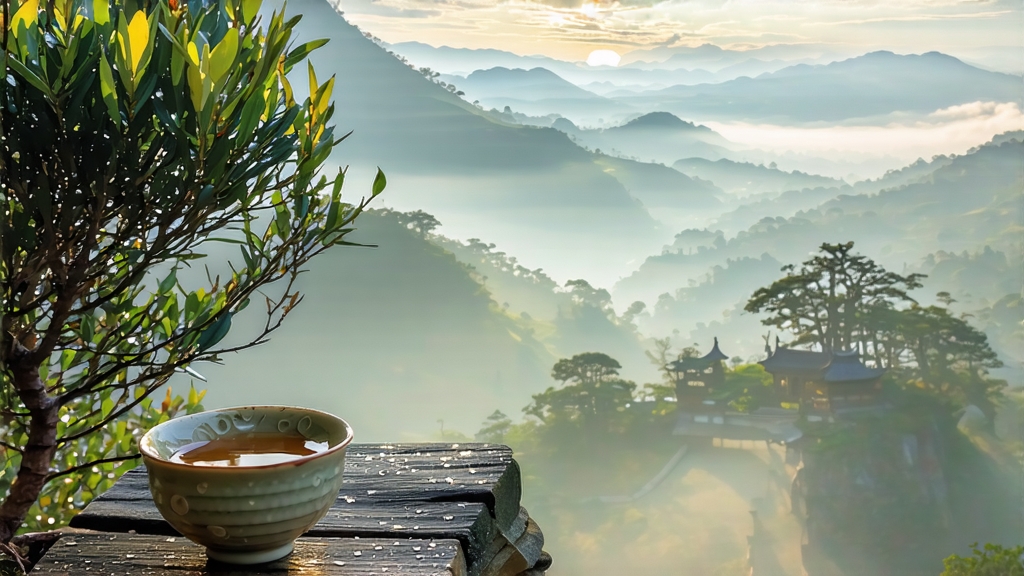
Tucked high above the Sichuan basin, where perpetual cloud curtains soften the morning light, lies Meng Ding Mountain, the cradle of the world’s oldest recorded tea garden. It was here, during the Tang dynasty (618-907 CE), that Buddhist monks first coaxed the tiny golden buds of Camellia sinensis into a tea so delicate that emperors decreed it gong cha—“tribute tea”—and sealed its harvest within silver-lined chests bound for the Forbidden City. Today that tea is called Meng Ding Huang Ya, literally “Meng Ding Yellow Bud,” the most luminous jewel in the slender crown of Chinese yellow tea. While yellow tea as a category has dwindled to near mythic status, Meng Ding Huang Ya survives as a living fossil of craftsmanship, a sip of mountain mist and imperial memory that refuses to vanish.
History: From Altar of Heaven to Forgotten Niche
Meng Ding’s tea destiny began in 53 BCE when the Daoist recluse Wu Lizhen planted seven tea bushes on the summit, an act later chronicled in the Gazetteer of Famous Mountains. By the Tang court, the buds were already freighted with symbolism: yellow was the emperor’s color, and the pale yellow liquor offered at the Altar of Heaven was read as a sign of cosmic harmony. Song dynasty tea competitions further refined plucking standards—only the unopened bud, or the bud with one barely unfurled leaf, picked before the Qingming festival, qualified. After the fall of the Qing in 1911, imperial demand evaporated; yellowing technique grew scarce, and Meng Ding Huang Ya retreated into local monasteries. When Chinese tea scholars “rediscovered” it in the 1970s while cataloguing endangered processing arts, fewer than twenty mountain families still possessed the oral formula. Today the tea enjoys Protected Geographical Indication status, yet annual production remains under three metric tons, making each kilogram a time capsule.
Terroir: Where Clouds Polish the Buds
Meng Ding sits at 29° north latitude, its granite spine rising to 1 456 m. Frequent cloud cover filters ultraviolet light, forcing the plant to synthesize more theanine and fewer bitter catechins. Night temperatures plummet, locking in floral precursors, while day warmth hovers around 18 °C, ideal for slow enzymatic activity. The mountain’s acidic red soil, rich in kaolin and organic leaf mold, drains quickly yet retains just enough moisture to stress the bushes into concentrating sugars in the tender tips. Finally, a perennial bamboo forest exudes a faintly sweet vapor that settles on the buds, adding a whisper of sugared bamboo to the finished leaf.
Plucking: One Bud to Rule Them All
The harvest window opens ten days before Qingming (early April) and closes with the first spring rain. Pickers climb pre-dawn, selecting only the apical bud sheathed in downy chartreuse scales, or the bud plus a single leaf no longer than the bud itself. A skilled picker gathers barely 400 g in a day—roughly 9 000 individual buds—enough for just 100 g of finished tea. The pluck is deposited into shallow bamboo baskets lined with banana leaf to prevent compression bruising, then carried downhill within two hours for fixation.
Craft: The Secret of Men Huang – Sealed Yellowing
Yellow tea’s defining step is men huang, a controlled re-fermentation that borrows from both green and black tea logics yet belongs to neither. The sequence unfolds in five meticulous acts:
-
Sha Qing (Kill-Green): Buds are tumble-fired for 90 seconds at 140 °C in iron woks hand-whittled from Meng Ding’s own ore. The goal is to rupture leaf membranes just enough to halt oxidative browning while preserving a living enzymatic core.
-
Re Shou (Hot Rubbing): At 60 °C, the partially wilted buds are rolled between cotton cloths, a motion that fractures cell walls without breaking the surface fuzz, releasing a milky sap that will later yellow.
-
Men Huang (Sealed Yellowing): The wrapped buds are stacked in oak boxes and buried under steamed rice straw. Over 48–72 hours the core temperature climbs to 35 °C, triggering anaerobic micro-fermentation. Chlorophyll degrades into pheophytin, catechins dimerize